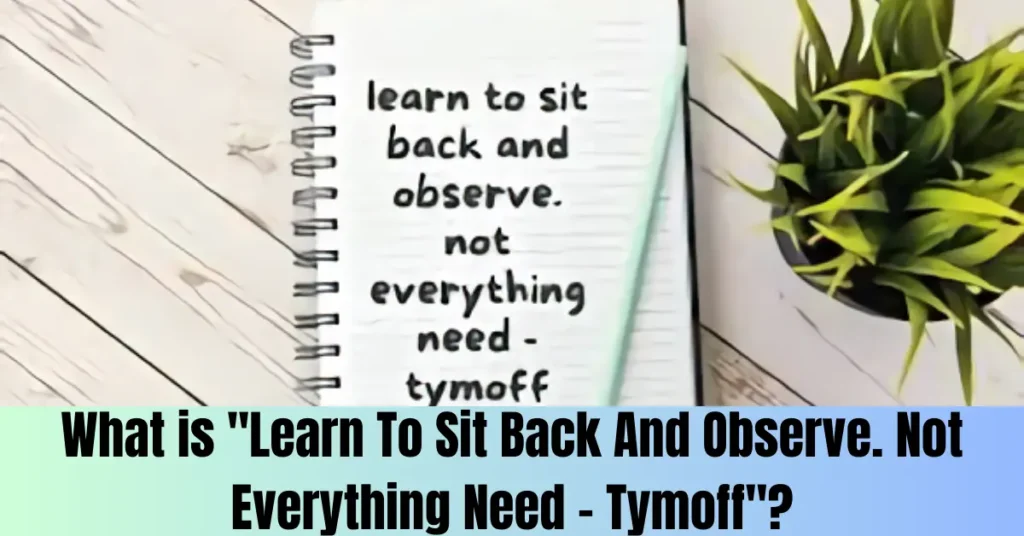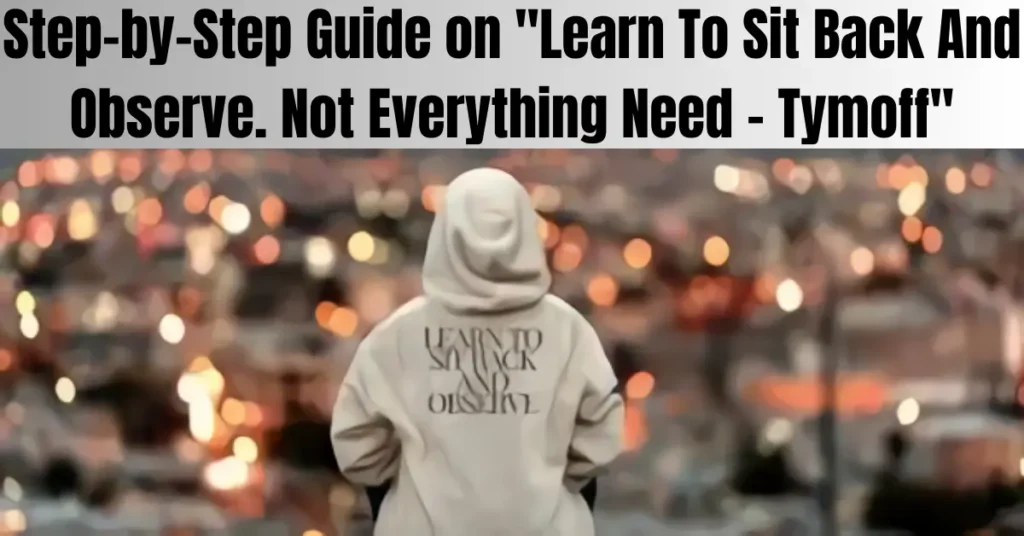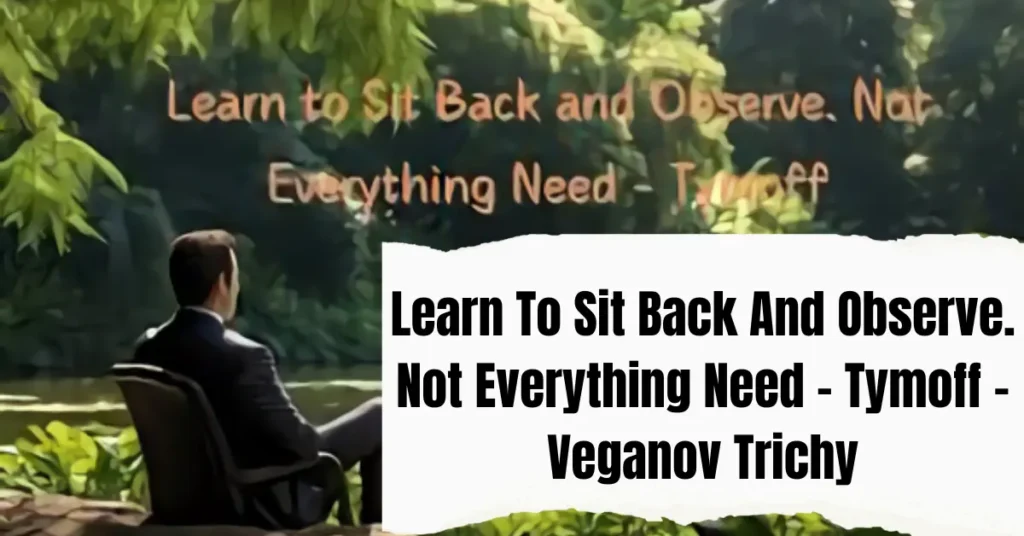Introduction
In our fast-paced world, it’s easy to get caught up in the hustle and bustle of everyday life. We often feel the need to react quickly to everything happening around us, but sometimes, the best approach is to take a step back and observe. This concept is beautifully captured in the phrase “Learn To Sit Back And Observe. Not Everything Need – Tymoff.”
By embracing this mindset, we can gain a clearer perspective, make better decisions, and find more peace in our daily lives. In this blog post, we’ll explore the benefits of learning to sit back and observe, and how this simple yet powerful practice can transform your approach to life’s challenges.
What is “Learn To Sit Back And Observe. Not Everything Need – Tymoff”?

- “Learn To Sit Back And Observe. Not Everything Need – Tymoff” is a reminder to take a step back from the constant urge to act or react to every situation immediately.
- In essence, it means developing the habit of observing your surroundings and the events unfolding around you without feeling the need to intervene or respond right away.
- This approach allows you to gain a deeper understanding and insight into the situation before taking any action.
- The phrase suggests that not everything requires your immediate attention or involvement.
- By learning to sit back and observe, you can differentiate between what truly needs your input and what can resolve itself without your interference.
- This practice can help reduce stress, improve decision-making, and create a sense of calm in your life.
- It’s about cultivating patience, mindfulness, and a greater awareness of the world around you.
You May Also Like It
Instagram Par Follower Kaise Badhaye With Can Follow Website – Veganov Trichy
1000+ Free Instagram Story Views In 2024 – Veganov Trichy
How To Increase Followers On Instagram With TakipciGir New Update 2024
Why is “Learn To Sit Back And Observe. Not Everything Need – Tymoff” Important?
Enhances Decision-Making
- Informed Choices: Taking the time to observe allows you to gather all necessary information, leading to more informed decisions.
- Reduces Impulsive Actions: Observing first helps to avoid rash decisions that you might regret later.
Reduces Stress and Anxiety
- Less Pressure to Act: Understanding that not everything requires immediate action can reduce the constant pressure to always be doing something.
- Calm and Composed: This approach promotes a sense of calm, as you’re not constantly reacting to every minor issue.
Improves Relationships
- Better Understanding: Observing others before responding can lead to a deeper understanding of their perspectives and feelings.
- Reduced Conflicts: Taking a step back helps in avoiding unnecessary arguments and misunderstandings.
Fosters Mindfulness
- Present Moment Awareness: Sitting back and observing helps you to be more present and aware of the current moment.
- Improved Focus: Mindfulness practices can improve your overall focus and attention span.
Encourages Personal Growth
- Self-Reflection: Observing situations and your own reactions to them can lead to valuable self-reflection and personal growth.
- Learning from Experience: You gain insights from watching how situations unfold, learning valuable lessons for the future.
Enhances Problem-Solving Skills
- Identifies Root Causes: Observing allows you to identify the root causes of problems rather than just addressing symptoms.
- Creative Solutions: A clearer understanding of a situation can lead to more creative and effective solutions.
Step-by-Step Guide on “Learn To Sit Back And Observe. Not Everything Need – Tymoff”

Step 1: Recognize the Urge to React
- Identify Triggers: Notice the situations that typically trigger an immediate reaction from you.
- Acknowledge Your Impulses: Be aware of your natural impulse to act or respond quickly.
Step 2: Pause and Breathe
- Take a Deep Breath: When you feel the urge to react, take a deep breath to center yourself.
- Count to Ten: Give yourself a moment to pause by counting to ten before responding.
Step 3: Observe the Situation
- Gather Information: Take a moment to observe the details of the situation. What is happening? Who is involved?
- Notice Body Language: Pay attention to the body language and expressions of those around you to gain additional context.
Step 4: Reflect on Your Thoughts and Emotions
- Check Your Emotions: Identify what emotions you are feeling. Are you angry, frustrated, or anxious?
- Analyze Your Thoughts: Consider why you are feeling this way and whether your thoughts are based on facts or assumptions.
Step 5: Consider the Bigger Picture
- Assess the Importance: Determine if the situation truly requires your immediate reaction or if it can wait.
- Evaluate the Impact: Think about the potential impact of your response. Will it help or harm the situation?
Step 6: Decide Whether to Act or Not
- Make a Conscious Choice: Decide if action is necessary or if it’s better to continue observing.
- Choose Your Response: If action is needed, choose a thoughtful and measured response rather than an impulsive one.
Step 7: Practice Patience
- Be Patient: Understand that learning to sit back and observe is a skill that takes time to develop.
- Forgive Yourself: If you find yourself reacting impulsively, forgive yourself and try again next time.
Step 8: Reflect and Learn
- Review Your Actions: After the situation has passed, reflect on how you handled it.
- Learn from Experience: Consider what you learned from observing and how you can apply it in the future.
Advantages
Improved Decision-Making
- Informed Choices: By observing first, you gather more information, leading to better decisions.
- Reduced Impulsiveness: Taking time to observe helps avoid hasty, regrettable decisions.
Reduced Stress and Anxiety
- Less Pressure: You don’t feel the need to respond to everything immediately, reducing stress.
- Calmer Mindset: Cultivating a habit of observation promotes a sense of calm and composure.
Enhanced Relationships
- Better Understanding: Observing others helps you understand their perspectives and emotions better.
- Fewer Conflicts: With a deeper understanding, you can avoid unnecessary arguments and misunderstandings.
Greater Mindfulness
- Present Moment Awareness: Observing helps you stay present and fully aware of the current moment.
- Improved Focus: Mindfulness practices can enhance your concentration and attention to detail.
Personal Growth
- Self-Reflection: Observing your reactions allows for valuable self-reflection and personal development.
- Learning from Experience: You can gain insights and learn important lessons from observing situations unfold.
Better Problem-Solving Skills
- Identifying Root Causes: Observation helps you understand the underlying causes of problems.
- Creative Solutions: A clearer understanding of the situation can lead to more innovative and effective solutions.
Disadvantages
Delayed Action
- Missed Opportunities: Taking too long to observe might result in missed chances that require prompt action.
- Perceived Inaction: Others might see your patience and observation as a lack of initiative or interest.
Overthinking
- Paralysis by Analysis: Excessive observation and reflection can lead to overthinking and difficulty making decisions.
- Increased Anxiety: Constantly analyzing every detail might increase anxiety instead of reducing it.
Social Perception
- Misunderstanding: People might misunderstand your intention to observe and wait, perceiving it as indifference or indecisiveness.
- Communication Issues: If not communicated properly, your observational approach might cause frustration among those expecting immediate responses.
Inefficiency in Urgent Situations
- Delayed Response: In emergencies or urgent situations, the time taken to observe and reflect can lead to ineffective handling of the situation.
- Risk of Inaction: There is a risk of becoming too passive, leading to inaction when immediate action is necessary.
Balancing Act
- Finding Balance: It can be challenging to find the right balance between observing and acting, especially in dynamic environments.
- Need for Adaptability: You need to be adaptable and know when to switch from observation to action based on the context.
What does “Learn To Sit Back And Observe. Not Everything Need – Tymoff” mean?
This phrase means taking the time to observe and understand situations before reacting. It suggests that not everything requires immediate action and sometimes, the best approach is to wait and watch.
Why is it important to sit back and observe?
Sitting back and observing helps you make better decisions, reduces stress, improves relationships, and fosters mindfulness. It allows you to gather more information and gain a clearer perspective before responding.
How can I start practicing this habit?
Start by recognizing the urge to react immediately. Take a deep breath, pause, and observe the situation. Reflect on your thoughts and emotions, consider the bigger picture, and decide if action is necessary. Practice patience and learn from your experiences.
What are the benefits of observing before acting?
The benefits include:
Better decision-making
Reduced stress and anxiety
Improved relationships
Greater mindfulness
Personal growth
Enhanced problem-solving skills
Are there any downsides to this approach?
Yes, some potential downsides include:
Delayed action in urgent situations
Overthinking and paralysis by analysis
Misunderstanding from others
Perceived inaction or lack of initiative
How can I balance observation and action?
To find the right balance, assess the importance and urgency of each situation. If immediate action is needed, act promptly. If not, take your time to observe and reflect. Practice adaptability and adjust your approach based on the context.
Conclusion
Learning to sit back and observe can transform how you handle life’s challenges. By taking a moment to pause and reflect, you make better decisions, reduce stress, and improve your relationships.
While it’s important to find the right balance between observation and action, this practice can lead to greater mindfulness and personal growth.
Remember, not everything requires an immediate response. Sometimes, the best approach is to simply watch, listen, and understand.
Bonus Points on “Learn To Sit Back And Observe. Not Everything Need – Tymoff”
Boosts Creativity
- Fresh Perspectives: By observing without immediate action, you can see things from different angles, sparking creative ideas and solutions.
Enhances Patience
- Patience Practice: Regularly sitting back and observing helps you cultivate patience, a valuable trait in both personal and professional life.
Builds Empathy
- Understanding Others: Observing people and situations closely helps you develop a deeper empathy and understanding for others’ experiences and feelings.
Encourages Learning
- Continuous Learning: Watching and listening more can expose you to new information and insights, fostering a habit of continuous learning.
Improves Communication Skills
- Thoughtful Responses: By taking time to observe, you can provide more thoughtful and considered responses, improving your overall communication skills.
Enhances Self-Control
- Self-Discipline: Learning to wait and observe strengthens your self-control and discipline, helping you manage impulses more effectively.
Supports Mental Health
- Calmer Mindset: Adopting this approach can lead to a calmer, more balanced mindset, positively impacting your overall mental health and well-being.
You May Also Like It
Trendzguruji.me – Computer, Cyber, Awareness, SEO, Health & Beauty Guide
TrendzGuruji.me Cyber Insights Hub
“What’s Up with Emerald Gems? Let’s Talk”
